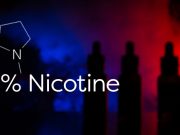Nicorette gum sales have definitely been on the decline, especially since the advent of e-cigarettes. In response to this, the brand is launching its first major new product in 10 years, a coated ice mint nicotine lozenge. The coating helps deliver a punch of minty flavor, offering a smoother texture than other nicotine lozenges that can sometimes be chalky.
Nicorette Gum was first approved by the FDA as a prescription smoking cessation drug in 1984 when Marion Merrell Dow (MMD) owned it. Subsequently GlaxoSmithKline started marketing the gum and NicoDerm CQ patch in 1996, when the FDA approved them as over-the-counter products.
Scientists at GSK spent seven years developing, studying and submitting the new lozenge for FDA review. Masking the bitter taste of nicotine is a major concern for consumers, said John Sienkiewicz, alliance director of GSK Consumer Healthcare’s Nicorette and NicoDerm brands.
“We know that quitting is very difficult, so we are always looking for ways to improve and bring a great usage experience to our nicotine replacement products,” said Scott Yacovino, Nicorette and NicoDerm brand director. “Obviously the better a product tastes as it relates to flavor and experience, hopefully the easier it is for people to stick to their quit journey.”
E-cigs are more effective than NRTs for smoking cessation
The NRT group had a 9.9% abstinence rate, while the vaping group had an abstinence rate of 18%.
Meanwhile, research has indicated that Nicorette and other NRTs are not very effective as smoking cessation aids, and the best results are obtained by using e-cigarettes.
A recent study, carried out by a team from London’s Queen Mary University and supported by the National Institute for Health Research, Health Technology Assessment Programme and Cancer Research UK, followed nearly 900 smokers through their quit attempts, looking at any symptoms they experienced, as well as their success at quitting.
A total of 886 participants were randomly divided into two groups. Members of one group were given regular NRTs (including combinations of products if they wanted it), while the other group were given a second-generation e-cigarette, with an 18mg/ml e-liquid bottle. After one year, the NRT group had a 9.9% abstinence rate, while the vaping group had an abstinence rate of 18%.
Nicorette Director: “E-cigs are not FDA approved for smoking cessation”
Naturally, Nicorette’s brand director does not view the vaping products favourably. “As far as we know, there is no clinical data to support e-cigarettes helping people to quit or to cede smoking,” Yacovino said. “They don’t have the same designation, they’re not FDA approved for smoking cessation like our products are.”
Besides being more effective, e-cigarettes also remain smokers’ cessation aids of choice as the motion of vaping, mimicking the action of smoking, makes the transition from smoking to not smoking an easier one, and Nicorette sales figures reflect this. In the last 5 years sales have decreased by 2%, although they increased to 3% between 2017 and 2018.
Read Further: CNBC












